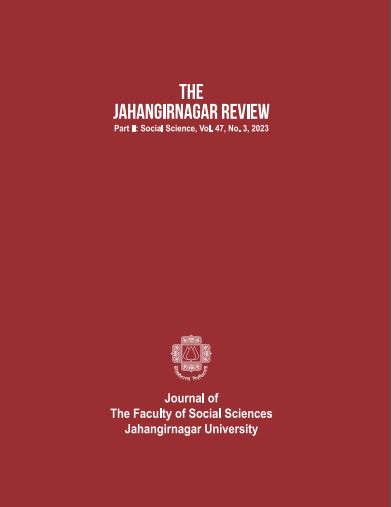Valuing Geodiversity Scope and Aspects in Chittagong Hill Tracts, Bangladesh
Main Article Content
Abstract
The Chittagong Hill Tracts (CHT) is one of Bangladesh's floristically diverse hill systems. This hilly area, located in southeastern Bangladesh, has been selected as a study area as an important regional spot of geodiversity and tourism. The main approach of this research was to explore the geodiversity of CHT using topographic and meteorological information. Several quantitative approaches were used to produce geodiversity information on CHT. Elevation data was the primary source of GIS analysis. The fuzzy approach was applied for the quantification of geodiversity. SAGA (System for Automated Geoscientific Analysis) GIS tool used to quantify geodiversity and primary and secondary data collected in this region's most attractive tourist spot. Bandarban has a very low area left for a low geodiversity area, and most of the location of this district has medium to high geodiversity. Rangamati and Khagrachhari districts also have a broader medium to high geodiversity scope. Though the elevation of Chittagong and Cox's Bazar districts is less than 300m, some areas belong to medium geodiversity. The area is distinguished by an extensive network of trellis and dendritic drainage, which is made up of several important rivers that flow to the Bay of Bengal. The main rivers are Karnafuli, Sangu, Matamuhuri, Feni, and their fluvial processes enriched the geodiversity of the area. The highest positive correlation (more than 50%) between geodiversity and explanatory variables was TRI (Terrain Ruggedness Index), and slope, which means the topographical variations contribute to the generation of geodiversity. Soil carbon stock and elevation also positively contribute around 35%. Temperature and TWI (Topographic Wetness Index) correlates negatively with geodiversity, and precipitation has a slightly positive relationship. Hill forests consist of tropical evergreen and semi-evergreen vegetation in this area. These forests cover an area of roughly 1.40 million ha and are located in the Rangamati, Bandarban, and Khagrachhari Hill Tracts, Chittagong districts. The tourism potentiality of the high geodiversity area is also significant in this region, where 51% of people visit the place for recreation. Additionally, 27% of people visited for knowledge and 11% for research. A family tour was 9%, and only 2% of people were for their business purpose. The hilly area has substantially wealthier geodiversity and has significant tangible values. The highly intricate processes that produce soil, climate, and terrain have taken thousands of years. But at the moment, tourism is eroding the land. Soil erosion is further aggravated by removing trees for agricultural farming or tourism attractions. Some significant Buddhist temples also exist, showing the area's cultural value.

